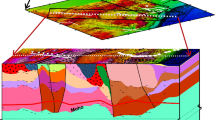Abstract
Harrat Lunayyir is one of the smaller lava fields in western Saudi Arabia that is of current interest due to a dike intrusion episode in 2009, an ongoing swarm of earthquakes and the possible hazard that pose. In addition to seismology, other geophysical data have been used to study the structure of the area, and the available aeromagnetic information is shown and discussed here. The reduced to the pole (RTP) magnetic grid and its enhancements have been used to define some of the main anomalies, and these have been correlated with the known geology, including the Red Sea coastal dike system. There are numerous linear features that are possibly related to the dikes or faulting, but within the area of the harrat, details due to the underlying structure are largely obscured by the magnetic surface lavas. Northeasterly trends in the magnetic data may indicate old zones of weakness that intersect one of the main coastal dikes at the location of the recent seismic activity and surface fissure, suggesting that this is a point of weakness resulting in the volcanism and seismicity that also appears to be largely limited to two of the NE trends. The association of the recent seismicity with a known geological and aeromagnetic feature is important in determining the seismic hazard for the region, especially if the location of future activity can be used to reduce overall uncertainty in the analysis by identifying potential fault sources. Here, the seismicity appears to lie on one of the NNW-trending coastal dikes that have been reactivated recently along a section between two NE-trending older faults.














Similar content being viewed by others
References
Al-Amri, A., and Fnais, M. (2010) Seismo-volcanic investigation of 2009 swarms at Harrat Lunayyir (Ash Shaqah), Western Saudi Arabia. Int J Earth Sci Eng
Al-Amri A, Fnais M, Abdel-Rahman K, Mogren S, Al-Dabbagh M (2012) Geochronological dating and stratigraphic sequences of Harrat Lunayyir, NW Saudi Arabia. International Journal of Physical Sciences 7(20):2791–2805
Baer G, Hamiel Y (2010) Form and growth of an embryonic continental rift: InSAR observations and modelling of the 2009 western Arabia rifting episode. Geophys J Int:13 pp. doi:10.1111/j.1365-246X.2010.04627.x
Blank HR (1977) Aeromagnetic and geological study of tertiary dikes and related structures on the Arabian margin of the Red Sea. Saudi Arabian directorate general of mineral resources, Red Sea research 1970–1975, Bulletin no. 22:G1–18
Bohannon RG, Naeser CW, Schmidt DL, Zimmermann RA (1989) The timing of uplift, volcanism, and rifting peripheral to the Red Sea: a case for passive rifting? J Geophys Res 94:1683–1701
Bosworth W (2015) Geological evolution of the Red Sea: historical background, review and synthesis. In: Rasul NMA, Stewart ICF (eds) The Red Sea. Springer Earth System Sciences, Berlin, pp 45–78. doi:10.1007/978-3-662-45201-1_3
Camp VE, Roobol MJ (1992) Upwelling asthenosphere beneath western Arabia and its regional implications. J Geophys Res 97(B11):15255–15271
Coleman RG, Gregory RT, Brown GF (1983) Cenozoic volcanic rocks of Saudi Arabia. Saudi Arabian deputy ministry for mineral resources. Open-File Report USGS-OF-03-93, 82 pp
Daradich A, Mitrovica JX, Pysklywec RN, Willett SD, Forte AM (2003) Mantle flow, dynamic topography, and rift-flank uplift of Arabia. Geology 31:901–904
Koulakov I, El Khrepy S, Al-Arifi N, Kuznetsov P, Kasatkina E (2015) Structural cause of a missed eruption in the Harrat Lunayyir basaltic field (Saudi Arabia) in 2009. Geology 43(5):395–398
McGuire AV, Bohannon RG (1989) Timing of mantle upwelling: evidence for a passive origin for the Red Sea rift. J Geophys Res 94:1677–1682
Mukhopadhyay B, Mogren S, Mukhopadhyay M, Dasgupta S (2012) Incipient status of dyke intrusion in top crust-evidences from the Al-Ays 2009 earthquake swarm, Harrat Lunayyir, SW Saudi Arabia. Geomat Nat Haz Risk:1–19
Pallister JS, WA MC, Jónsson S, Lu Z, Zahran HM, El Hadidy S, Aburukbah A, ICF S, Lundgren PR, White RA, MRH M (2010) Broad accommodation of rift-related extension recorded by dike intrusion in Saudi Arabia. Nat Geosci 3:705–712. doi:10.1038/NGEO966 8 pp, with supplementary information, 5 pp
Rasul NMA, Stewart ICF, Nawab ZA (2015) Introduction to the Red Sea: its origin, structure and environment. In: NMA R, ICF S (eds) The Red Sea: the formation, morphology, oceanography and environment of a Young Ocean basin. Springer Earth System Sciences, Berlin , pp 1–28. doi:10.1007/978-3-662-45201-1_1ISBN 978-3-662-45200-4, ISBN 978-3-662-45201-1 (eBook)
Roobol MJ, al-Rehaili M (1998) Geohazards along the Makkah-Madinah-Nafud (MMN) volcanic line. Saudi Arabian Deputy Ministry for Mineral Resources Technical Report BRGM-TR-98-9, 20 pp, 11 figs, 1 table
Roobol MJ, Stewart ICF (2009) Cenozoic faults and recent seismicity in northwest Saudi Arabia and the Gulf of Aqaba region. Saudi Geological Survey Technical Report SGS-TR-2008-7, 35 pp, 35 figs, 2 apps, 10 plates
Stern RJ, Johnson P (2010) Continental lithosphere of the Arabian Plate: a geologic, petrologic, and geophysical synthesis. Earth-Science Rev 101:29–67
Stoeser DB, Jackson NJ, Ramsay CR, Drysdall AR, du Bray EA, Douch CJ (1985) Map of the plutonic rocks in the Arabian Shield, Kingdom of Saudi Arabia (Northern Sheet). In: Felsic plutonic rocks and associated mineralization of the Kingdom of Saudi Arabia. Deputy Ministry for Mineral Resources, Jeddah, Mineral Resources Bulletin 29
Verduzco B, Fairhead JD, Green CM, Mackenzie C (2004) New insights into magnetic derivatives for structural mapping. Leading Edge 23:116–119
Zahran HM, Stewart ICF, Johnson PR, Basahel MH (2003) Aeromagnetic-anomaly maps of central and western Saudi Arabia. Saudi Geological Survey Open-File Report SGS-OF-2002-8, 6 pp, 1 fig, 1 table, 4 sheets (scale 1:2,000,000)
Acknowledgements
The work was carried out at the King Abdulaziz University, Kingdom of Saudi Arabia, as part of the first author’s Ph.D. studies. The authors would also like to thank Dr. Ian C.F. Stewart for assistance with the interpretation of the data. We also would like to thank Dr Hussein Mohammad Harbi and Dr Ali Hadi Atef for useful discussions and comments aboutthe Aeromagnetic processing and interpretations.
Author information
Authors and Affiliations
Corresponding author
Rights and permissions
About this article
Cite this article
Zahran, H.M., El-Hady, S.M. & Abuelnaga, H.S. Aeromagnetic data over Harrat Lunayyir and surrounding areas, western Saudi Arabia. Arab J Geosci 10, 63 (2017). https://doi.org/10.1007/s12517-017-2849-8
Received:
Accepted:
Published:
DOI: https://doi.org/10.1007/s12517-017-2849-8




